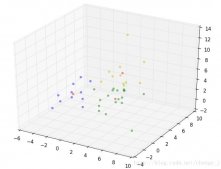傳統Python語言的主要控制結構是for循環。然而,需要注意的是for循環在Pandas中不常用,因此Python中for循環的有效執行并不適用于Pandas模式。一些常見控制結構如下。
- for循環
- while循環
- if/else語句
- try/except語句
- 生成器表達式
- 列表推導式
- 模式匹配
所有的程序最終都需要一種控制執行流的方式。本節介紹一些控制執行流的技術。
01 for循環
for循環是Python的一種最基本的控制結構。使用for循環的一種常見模式是使用range函數生成數值范圍,然后對其進行迭代。
|
1
2
3
4
5
6
7
8
9
10
11
12
13
|
res = range(3) print(list(res)) #輸出:[0, 1, 2] for i in range(3): print(i) '''輸出: 0 1 2 ''' |
for循環列表
使用for循環的另一種常見模式是對列表進行迭代。
|
1
2
3
4
5
6
7
8
9
10
|
martial_arts = ["Sambo","Muay Thai","BJJ"] for martial_art in martial_arts: print(f"{ martial_art} has influenced\ modern mixed martial arts") '''輸出: Sambo has influenced modern mixed martial arts Muay Thai has influenced modern mixed martial arts BJJ has influenced modern mixed martial arts ''' |
02 while循環
while循環是一種條件有效就會重復執行的循環方式。while循環的常見用途是創建無限循環。在本示例中,while循環用于過濾函數,該函數返回兩種攻擊類型中的一種。
|
1
2
3
4
5
6
7
8
9
10
11
12
13
14
15
16
17
18
19
20
21
22
23
|
def attacks(): list_of_attacks = ["lower_body", "lower_body", "upper_body"] print("There are a total of {lenlist_of_attacks)}\ attacks coming!") for attack in list_of_ attacks: yield attack attack = attacks() count = 0while next(attack) == "lower_body": count +=1 print(f"crossing legs to prevent attack #{count}") else: count += 1 print(f"This is not lower body attack, \ I will cross my arms for# count}") '''輸出: There are a total of 3 attacks coming! crossing legs to prevent attack #1 crossing legs to prevent attack #2 This is not a lower body attack, I will cross my arms for #3 ''' |
03 if/else語句
if/else語句是一條在判斷之間進行分支的常見語句。在本示例中,if/elif用于匹配分支。如果沒有匹配項,則執行最后一條else語句。
|
1
2
3
4
5
6
7
8
9
10
11
12
13
14
15
|
def recommended_attack(position): """Recommends an attack based on the position""" if position == "full_guard": print(f"Try an armbar attack") elif position == "half_guard": print(f"Try a kimura attack") elif position == "fu1l_mount": print(f"Try an arm triangle") else: print(f"You're on your own, \ there is no suggestion for an attack") recommended_attack("full_guard")#輸出:Try an armbar attack recommended_attack("z_guard") #輸出:You're on your own, there is no suggestion for an attack |
04 生成器表達式
生成器表達式建立在yield語句的概念上,它允許對序列進行惰性求值。生成器表達式的益處是,在實際求值計算前不會對任何內容進行求值或將其放入內存。這就是下面的示例可以在生成的無限隨機攻擊序列中執行的原因。
在生成器管道中,諸如 “arm_triangle”的小寫攻擊被轉換為“ARM_TRIANGLE”,接下來刪除其中的下劃線,得到“ARM TRIANGLE”。
|
1
2
3
4
5
6
7
8
9
10
11
12
13
14
15
16
17
18
19
20
21
22
23
24
25
26
27
28
29
30
31
32
33
34
35
36
37
38
39
40
41
42
43
|
def lazy_return_random_attacks(): """Yield attacks each time""" import random attacks = {"kimura": "upper_body", "straight_ankle_lock": "lower_body", "arm_triangle": "upper_body", "keylock": "upper_body", "knee_bar": "lower_body"} while True: random_attack random.choices(list(attacks.keys())) yield random attack #Make all attacks appear as Upper Case upper_case_attacks = \ (attack.pop().upper() for attack in \ lazy_return_random_attacks()) next(upper-case_attacks) #輸出:ARM-TRIANGLE ## Generator Pipeline: One expression chains into the next #Make all attacks appear as Upper Case upper-case_attacks =\ (attack. pop().upper() for attack in\ lazy_return_random_attacks()) #remove the underscore remove underscore =\ (attack.split("_")for attack in\ upper-case_attacks) #create a new phrase new_attack_phrase =\ (" ".join(phrase) for phrase in\ remove_underscore) next(new_attack_phrase) #輸出:'STRAIGHT ANKLE LOCK' for number in range(10): print(next(new_attack_phrase)) '''輸出: KIMURA KEYLOCK STRAIGHT ANKLE LOCK ''' |
05 列表推導式
語法上列表推導式與生成器表達式類似,然而直接對比它們,會發現列表推導式是在內存中求值。此外,列表推導式是優化的C代碼,可以認為這是對傳統for循環的重大改進。
|
1
2
3
4
5
6
7
|
martial_arts = ["Sambo", "Muay Thai", "BJJ"] new_phrases [f"mixed Martial Arts is influenced by \ (martial_art)" for martial_art in martial_arts] print(new_phrases) ['Mixed Martial Arts is influenced by Sambo', \ 'Mixed Martial Arts is influenced by Muay Thai', \ 'Mixed Martial Arts is influenced by BJJ'] |
06 中級主題
有了這些基礎知識后,重要的是不僅要了解如何創建代碼,還要了解如何創建可維護的代碼。創建可維護代碼的一種方法是創建一個庫,另一種方法是使用已經安裝的第三方庫編寫的代碼。其總體思想是最小化和分解復雜性。
使用Python編寫庫
使用Python編寫庫非常重要,之后將該庫導入項目無須很長時間。下面這些示例是編寫庫的基礎知識:在存儲庫中有一個名為funclib的文件夾,其中有一個_init_ .py文件。要創建庫,在該目錄中需要有一個包含函數的模塊。
首先創建一個文件。
touch funclib/funcmod.py
然后在該文件中創建一個函數。
|
1
2
3
4
5
6
7
8
9
10
|
"""This is a simple module"""def list_of_belts_in_bjj(): """Returns a list of the belts in Brazilian jiu-jitsu""" belts= ["white", "blue", "purple", "brown", "black"] return belts import sys;sys.path.append("..") from funclib import funcmod funcmod.list_of_belts_in-bjj() #輸出:['white', 'blue', 'purple', 'brown', 'black'] |
導入庫
如果庫是上面的目錄,則可以用Jupyter添加sys.path.append方法來將庫導入。接下來,使用前面創建的文件夾/文件名/函數名的命名空間導入模塊。
安裝第三方庫
可使用pip install命令安裝第三方庫。請注意,conda命令(
https://conda.io/docs/user-guide/tasks/manage-pkgs.html)是pip命令的可選替代命令。如果使用conda命令,那么pip命令也會工作得很好,因為pip是virtualenv虛擬環境的替代品,但它也能直接安裝軟件包。
安裝pandas包。
pip install pandas
另外,還可使用requirements.txt文件安裝包。
|
1
2
3
4
5
6
7
8
9
|
> ca requirements.txt pylint pytest pytest-cov click jupyter nbval > pip install -r requirements.txt |
下面是在Jupyter Notebook中使用小型庫的示例。值得指出的是,在Jupyter Notebook中創建程序代碼組成的巨型蜘蛛網很容易,而且非常簡單的解決方法就是創建一些庫,然后測試并導入這些庫。
|
1
2
3
4
5
6
7
8
9
10
11
12
13
14
15
16
17
18
19
20
21
22
|
"""This is a simple module""" import pandas as pd def list_of_belts_in_bjj(): """Returns a list of the belts in Brazilian jiu-jitsu""" belts = ["white", "blue", "purple", "brown", "black"] return belts def count_belts(): """Uses Pandas to count number of belts""" belts = list_of_belts_in_bjj() df = pd.Dataframe(belts) res = df.count() count = res.values.tolist()[0] return count from funclib.funcmod import count_belts print(count_belts()) #輸出:5 |
類
可在Jupyter Notebook中重復使用類并與類進行交互。最簡單的類類型就是一個名稱,類的定義形式如下。
class Competitor: pass
該類可實例化為多個對象。
|
1
2
3
4
5
6
7
8
9
10
11
12
13
14
15
16
17
18
19
|
class Competitor: passconor = Competitor() conor.name = "Conor McGregor"conor.age = 29conor.weight = 155nate = Competitor() nate.name = "Nate Diaz"nate.age = 30nate.weight = 170def print_competitor _age(object): """Print out age statistics about a competitor""" print(f"{object.name} is {object.age} years old") print_competitor_age(nate) #輸出:Nate Diaz is 30 years old print_competitor_age(conor) #輸出:Conor McGregor is 29 years old |
類和函數的區別
類和函數的主要區別包括:
- 函數更容易解釋。
- 函數(典型情況下)只在函數內部具有狀態,而類在函數外部保持不變的狀態。
- 類能以復雜性為代價提供更高級別的抽象。
總結
到此這篇關于Python的控制結構:For、While、If…的文章就介紹到這了,更多相關Python控制結構 If、While、For內容請搜索服務器之家以前的文章或繼續瀏覽下面的相關文章希望大家以后多多支持服務器之家!
原文鏈接:http://developer.51cto.com/art/202006/619865.htm












